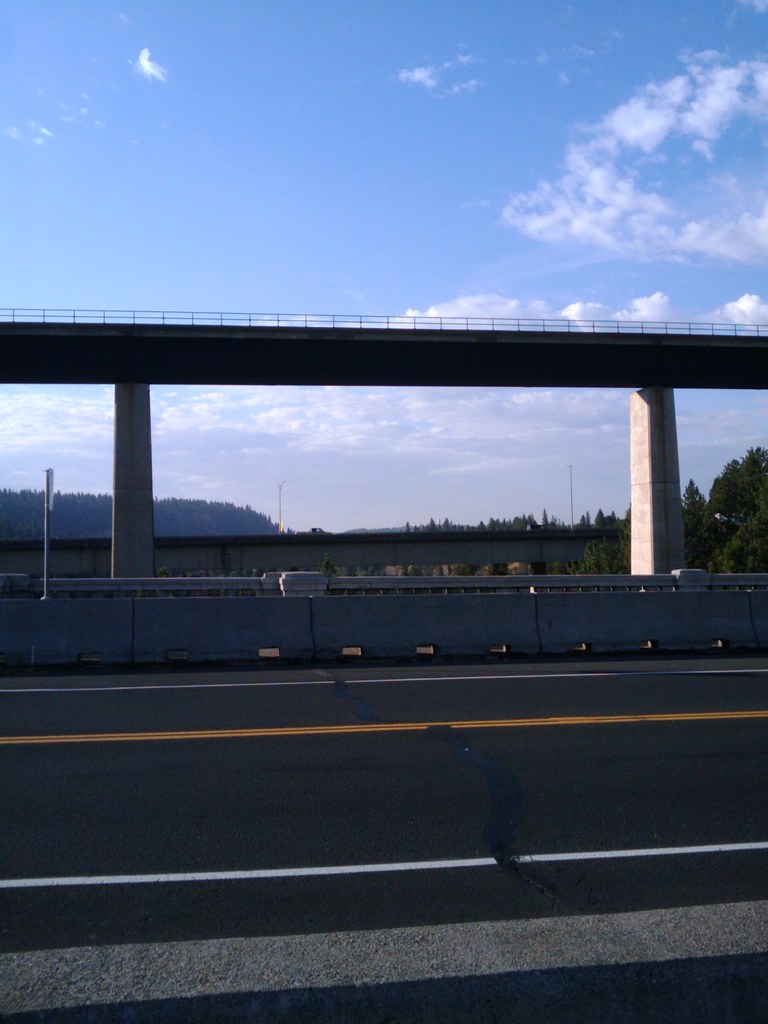
The Latah Bridge, also known as the Sunset Boulevard Bridge, in Spokane, Washington, offers a unique train observation spot. Spanning the Latah Creek, this historic concrete arch bridge provides scenic views of passing trains below, set against the backdrop of lush greenery and the creek's natural beauty.
Photos
Sign in to upload photos
No Photos Yet
Be the first to share photos of this location!
Latah Bridge (Spokane) – Spokane, Washington, USA | Train Spotting Location
Trainspotting Experience
Most visitors set up on the rim trails along West Sunset Boulevard, where the bridge’s 3,950-foot length curves gently into view. Expect trains to appear with minimal warning; horns are rare until they enter the nearby Latah Junction switches, so vibration on the rails is often the first hint. South-eastern approaches hide behind basalt outcrops, then locomotives burst onto the trestle at roughly 35–40 mph. Freight consists can stretch for two miles, taking four or five minutes to clear the span while their wheel flanges screech against the bridge’s slight curvature. Sound carries remarkably well in the bowl-shaped canyon—each chug, flange squeal, and air-compressor burst reverberates off rock walls, creating an immersive acoustic show. Nighttime visits reward patient spotters with the glow of headlamps reflecting off steel girders and the distant city lights of downtown Spokane.
Landscape, Setting & Local Atmosphere
Latah Bridge straddles a 250-foot-deep canyon carved by Ice Age floods. The north rim offers open basalt shelves, native bunchgrass, and scattered ponderosa pines; the south rim transitions to mixed residential lots and city parkland. Elevations near the viewing pullouts sit around 2,200 feet above sea level, providing crisp, pine-scented air. Summers bring hot, dry afternoons with clear skies, ideal for backlit evening shots, while winters can add dramatic dustings of snow on both the bridge trusses and the orange BNSF locomotives. Wind is common in shoulder seasons—tripods and lens hoods help steady long exposures.
Type & Frequency of Train Activity
The bridge carries BNSF Railway’s busy Columbia River Subdivision, part of the primary Seattle–Chicago corridor. On an average weekday, railfans can expect:
• 35–45 freight movements, heavily weighted toward unit grain, mixed manifests, and double-stack intermodal.
• Two daily Amtrak Empire Builder sections (westbound #7 in the predawn hours, eastbound #8 just after midnight) that are combined or split at Spokane station two miles east before crossing Latah Creek.
• Occasional Union Pacific detours when UP’s Spokane Subdivision is under maintenance; these trains add visual variety with yellow power lash-ups.
Because the line is double-tracked across the bridge, meets are frequent—nothing beats the sight of opposing trains thundering past each other 200 feet above the creek.
Best Angles for Photos & What Railfans Enjoy Most
- Sunset Boulevard Overlook: A gravel turnout just west of the bridge offers a three-quarter angle of eastbound trains with Mount Spokane faintly visible 50 miles beyond on exceptionally clear days. Afternoon light strikes the engineer’s side, highlighting logos and locomotive detail.
- Finch Arboretum Trail: A short hike down the canyon wall positions photographers at creek level, capturing dramatic under-bridge perspectives that emphasize the height of the Warren deck truss center section. Wide-angle lenses (16–24 mm) fit the entire span.
- South Rim Residential Easement: Morning light favors westbounds; telephoto shots (200 mm) compress trains against the skyline of Spokane’s Riverside neighborhood.
Neutral-density filters help balance bright skies, and polarized glass cuts glare off the steelwork after rain. Drone use is discouraged; the area sits beneath Spokane International Airport’s approach path.
Historical or Cultural Relevance
Completed in 1973 by Burlington Northern to replace an aging timber trestle, Latah Bridge was one of the last major steel railroad bridges built in the Pacific Northwest. Its construction eliminated a notorious 15 mph bottleneck and enabled heavier unit trains vital to the wheat economy east of the Cascades. The span’s nickname, “High Bridge,” is still used by local crews and dispatchers. Nearby highway bridges, including Interstate 90’s deep-deck structure, create a layered transportation tableau illustrating Spokane’s role as a regional crossroads.
What Makes This Spot Different
Unlike many railfan locations that require distant vistas or fence peering, Latah Bridge offers close-range, eye-level views of trains riding a sky-high deck—no trespassing or special permits needed. The natural amphitheater of Latah Creek amplifies sound, turning each consist into a rolling concert, while the juxtaposition of rugged canyon, evergreen slopes, and urban skyline is uniquely Spokane. Few places allow photographers to capture double-stack containers seemingly floating above treetops with a backdrop of both wilderness and cityscape.
Localisation
Coordonnées :47.647670, -117.451137
Seasonal Information
The Latah Bridge in Spokane offers scenic train views year-round. Spring and fall provide mild weather and vibrant scenery. Summer offers long daylight hours, while winter's snow adds a picturesque touch. Check local schedules for special train events or excursions.
Other Interesting Locations
Looking for more spots? Browse the complete list of train spotting locations.
Quick Information
Country
USA
Region / State / Province
Washington
City
Spokane
Spot Type
Bridge
Best Times
Best hours to observe trains at Latah Bridge are during daylight, especially morning (7-9 AM) and evening (5-7 PM) on weekdays for peak train activity.
